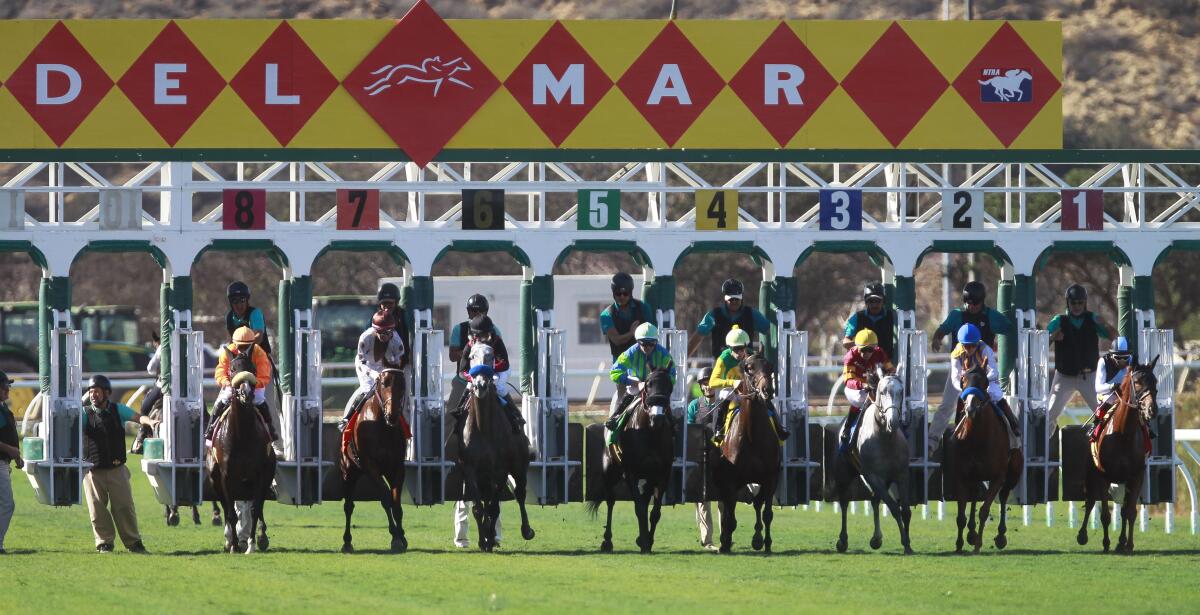Del Mar opens safety briefing by announcing death of horse in accident

- Share via
DEL MAR — The irony was palpable when Josh Rubinstein, chief operating officer at Del Mar, opened up a Breeders’ Cup panel on health and safety protocols with news of a horse death Wednesday morning at a facility that is considered the safest big track in America.
It was the fifth racing or training fatality at the track this year, which is well below most major tracks. According to the Equine Injury Database, Del Mar has the lowest percentage of racing fatalities at a major track. But the EID does not count training deaths, which made up four of Del Mar’s five this year.
Set the Tone, a 2-year-old filly, lost her rider during training, the bridle came loose and the saddle slipped underneath her. As she tried to exit the track, she hit a pole on a fence causing a wound and an unrepairable shoulder injury. She was immediately attended to by veterinarians and the decision was made to euthanize her. The filly, trained by Bob Hess, had run three times, finishing second twice. She was not entered in any Breeders’ Cup races.
Trainer Bob Baffert has agreed to unprecedented screening, observation and testing as a condition of being allowed to run his horses in the Breeders’ Cup next month.
“Yeah, definitely challenging to start off a safety briefing having to cover a freak accident,” Rubinstein said.
The Del Mar executive estimated a loose horse happens “probably once a week” during normal meets.
“It does happen from time to time,” Rubinstein said. “We have protocols in place, which you saw [Wednesday]. There’s a siren, there’s a PA announcement, we close the gates so the horse is not able to run off the grounds.”
It was at least the fourth situation involving a loose horse at Del Mar this week.
On Tuesday, a horse rushed down the front-side barn area after exiting the track. Trainer Peter Miller, in a hooded sweatshirt and jeans, stood in the path with arms extended to slow the horse.
The horse side-stepped Miller, curled around the corner of his barn and was brought under control seconds later.
Breeders’ Cup officials said the situation was not reported to them, so it was unclear whether the horse was an entrant for the $28 million weekend. Rubinstein said his group was not made aware of the incident, either.
“It’s probably not the smartest thing in the world to try and stop a runaway train,” said Miller, who indicated he briefly had one of his own horses run loose without incident Wednesday.
Record number of entries, from Japan to South Africa, add spice to richest horse-racing event
Before Wednesday’s fifth race, Charge Cash dumped his rider and ran unattended down the backstretch around the far turn and through the front stretch before an outrider corralled him as he was getting perilously close to a car that was parked near the finish line.
The Breeders’ Cup, which will be run Friday and Saturday, brings an army of veterinarians and safety experts to its annual event all in the hope of not having a death occur before a national television audience.
It’s happened 14 times in the 37 previous runnings, but few as high profile as 2019 when Mongolian Groom was fatally injured while running in the Classic at Santa Anita in 2019. The track was in the midst a fatality crisis in which 37 horses died during its two meetings. The situation became a national story and the track even shut down for a month to try and figure out why this was happening. It sparked serious safety reforms in the sport, most of which are ongoing.
The Breeders’ Cup commissioned a study on Mongolian Groom’s death by noted Kentucky veterinarian Dr. Larry Bramlage in which it was determined the death could have been prevented.
“The examining veterinarians made the right call on 252 horses,” the report said. “That is a 99.6% accuracy rate. The decision was wrong on only one horse: Mongolian Groom.”
As a result of the report, the Breeders’ Cup has changed some its ways of doing things.
“One of things that came out of that was the trot up exam allowing us to examine [horses] in a confined area with the weight on their back rather than en masse while they are training on the track,” said Dr. Will Farmer, a co-leader of the Breeders’ Cup veterinary team.
Bob Baffert has cultivated the story of a horse racing dynasty built from humble roots. He now faces scrutiny about short cuts he’s alleged to have taken.
Farmer also said they use the same veterinarian examining each horse during the time before the race.
“Having a different set of eyes on a horse is very helpful but having a consistent set of eyes is also helpful,” Farmer said. “We manage our teams, so we have a fresh set and a consistent set.”
Protocols also have changed from almost exclusive barn exams to a split between barn and track exams.
In the wake of the 2019 fatality crisis, the California Horse Racing Board now requires a panel of three people reviewing a horse’s record before running in a race. It was expanded to five for the Breeders’ Cup.
Estilo Talentoso, who was scheduled to run in the Filly and Mare Sprint, was scratched by the panel upon the advice of veterinarians, according to Dr. Jeff Blea, equine medical director of the CHRB and a member of the panel.
Wednesday’s briefing also addressed the situation involving trainer Bob Baffert, who agreed to undergo expanded scrutiny after five medication positives in about a year, including Kentucky Derby winner Medina Sprit. Two of the positives were the result of contamination which affected other barns and Baffert has yet to be charged with anything involving Medina Spirit. The 3-year-old colt is scheduled to run in the Classic on Saturday.
Farmer confirmed Baffert’s horses have undergone extra testing week but would not specify how many times or which horses.
More to Read
Go beyond the scoreboard
Get the latest on L.A.'s teams in the daily Sports Report newsletter.
You may occasionally receive promotional content from the Los Angeles Times.















